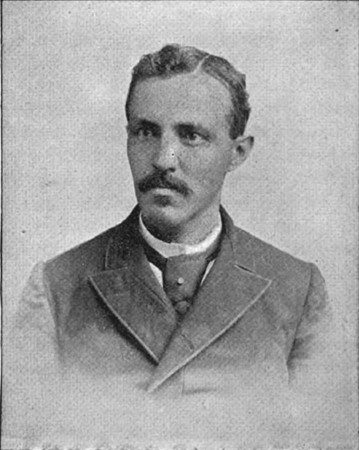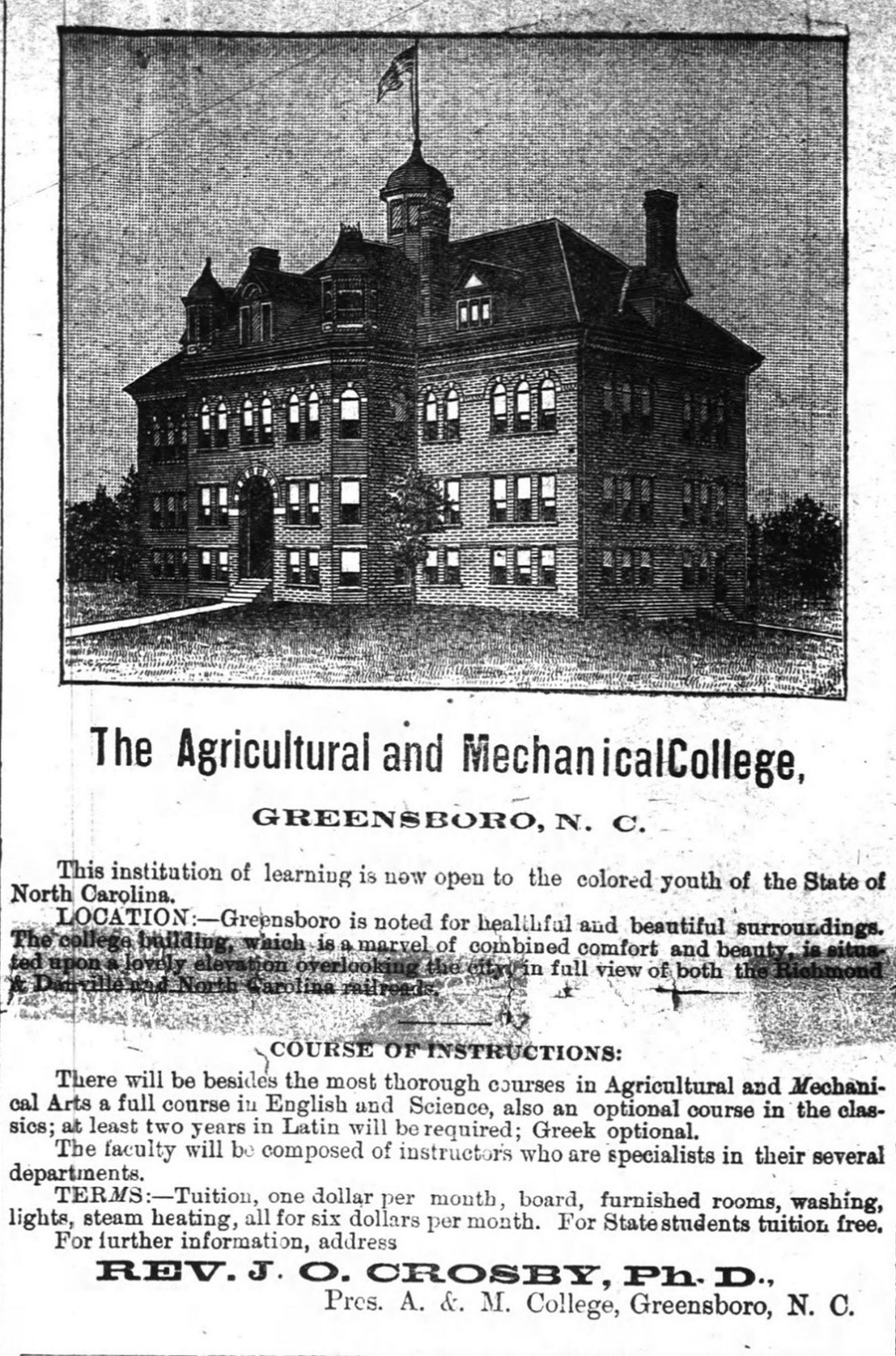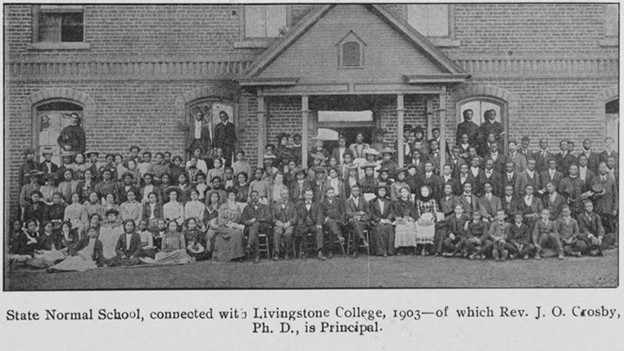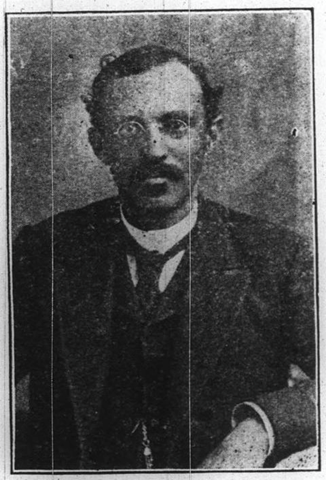December 22, 1850 – August 22, 1929
See also: Crosby, Henry Clay

Rev. John Oliver Crosby Sr., PhD, was a Baptist minister, school administrator, Constitutional representative, newspaper publisher, orator, and carpenter active in the Reconstruction and Post-Reconstruction eras of the Carolinas. He is best remembered as the first president of the Agricultural and Mechanical College for the Colored Race (now known as North Carolina Agricultural and Technical State University) in Greensboro, N.C. He served as president from 1892 until 1896.
John O. Crosby was born enslaved around 1850 in Crosbyville, Fairfield County, South Carolina. While his birth date is believed to be December 22, 1850, slave records indicate that Crosby could have been born as early as 1848. His mother was an enslaved woman known only as Sylvia. His father was Thomas Crosby, an enslaver of Scotch-Irish ancestry. Thomas Crosby purchased Sylvia from John Tinsley of Sussex, Virginia to settle a debt.
It is unknown how many siblings Crosby had, but according to historical records, Sylvia probably had four children: John, Henry, Belle, and Hannah. John’s most well-known sibling was a younger brother, Dr. Henry Clay Crosby (1855 – 1897). John and Henry were separated following the death of their father Thomas Crosby in 1860. John was then enslaved by Mary Q. Crosby (a relative of Thomas Crosby), and soon after by her husband, James (William) Stanton, after their marriage around 1861.
Stanton took Crosby with him as an enslaved man when he went into military service during the Civil War. They were stationed at a Confederate prison camp near Columbia, South Carolina, possibly Camp Sorghum. According to Crosby, he helped Union prisoners in the camp by informing them about Confederate battle efforts and aiding them in escape.
Crosby and his brother Henry were reunited with their mother in Chester County, S.C., towards the end of the war. Their new stepfather, whom John did not name, disapproved of the brothers’ desire for an education. As a result, John and Henry walked over twenty-five miles to Winnsboro, S.C., where they enrolled in the newly formed Freedman’s School.

In the spring of 1869, Crosby became a census clerk and Freedom Party delegate for Fairfield County, S.C., until he moved to Charlotte, N.C., that fall to enroll in Biddle University (now Johnson C. Smith University). Crosby converted to the Baptist denomination and transferred to Shaw University in Raleigh in 1870. There, he earned his Bachelor of Arts degree in 1874. His earliest known ministerial work began in the summer of 1872 as a missionary for the American Baptist Home Mission Society, building churches in Mecklenburg County.
In 1874, Crosby became the pastor of the Colored Warrenton Baptist Church in Warrenton, N.C., where he pastored for six years. During this time, he also worked as a Warren County school principal and represented the Black constituents of Warren County as a delegate to the 1875 North Carolina Constitutional Convention.
Crosby married Georgiana Birdsong (also known as Birdsoe) in 1874. Their union lasted until she died in 1881. John and Georgiana had one son, William S. Crosby, in 1875. William, like his father and uncle, worked in education, serving as a school principal in Midwestern states from the 1910s to the 1930s.
In 1880, Crosby became the pastor of the Dixonville Baptist Church (now First Calvary Baptist Church) in Salisbury. He was also the first principal of the Salisbury State Normal School, which operated in the church beginning in 1881. Crosby became more prominent during this time, with increased wealth and land ownership.
Crosby made history as one of the first Black people to graduate from the National School of Elocution and Oratory of Philadelphia around 1886. Newspaper articles state that he spent his summers continuing his education at a school in Martha’s Vineyard, Massachusetts.
Crosby is known to have written newspaper articles as early as 1881 and may have influenced other Baptist ministers to publish newspapers. During the summer of 1886, Crosby published a newspaper for African American Baptists called The Gold Dust. While no copies of this newspaper are known to exist today, an article reprint can be read in the sole existing issue of the African Expositor, which was published by Rev. Nicholas Franklin Roberts of Raleigh. The Salisbury Watchman from August 5, 1886, also mentions The Gold Dust in a column about local events.
In the fall of 1887, Crosby married Elmira Richards, a graduate of Barber-Scotia Seminary, now Barber-Scotia College. He and Elmira had five children. Their names were: Mary, John Jr., Mabel, Spurgeon, and Elmira. Crosby resigned from the pastorate of the Dixonville Baptist Church in 1889 but continued as principal of the Salisbury Normal School. Crosby was also elected as moderator for the Rowan County Baptist Association as early as 1889. Crosby held the position several times and served on the county’s education board.
By the early 1890s, Crosby was known as one of the wealthiest men in Rowan County with an estimated worth of $10,000. He was also one of the most esteemed preachers in Baptist fellowships and is believed to have baptized over 1,200 people. He earned a Doctorate of Philosophy from Shaw University in 1891.

At forty-one, Dr. Crosby became one of five final candidates for the presidency of the newly formed Agricultural and Mechanical College for The Colored Race. The Board of Trustees cast seven ballots, and Dr. Crosby was declared the new president on May 25, 1892.
Crosby presented his plan for a program of study to the Board of Trustees in June of 1893. The courses consisted of language and literature, penmanship, industrial drawing, tool instruction, mathematics, a broad range of sciences, and military science and tactics. The variety of skills he envisioned for agricultural and mechanical students showed that Crosby valued a well-rounded education. In 1894, he allotted funding to create the school newspaper, The Register, and the first campus bulletin. These publications were designed to inform the public about the new college. From 1893 to 1896, Crosby oversaw the construction of the first three campus buildings, designed by the architectural firm of Orlo Epps. Some school histories claim that Crosby made the first brick for the building construction. He also led the A. and M. Board of the Baptist State Convention, which was the school’s earliest known campus ministry.

Crosby resigned from the presidency in 1896 amid growing criticism of his leadership and internal conflicts with faculty and the Board of Trustees. That same year, James B. Dudley took over as his successor. Crosby was reinstated as the principal of the Salisbury Normal School a year later. In addition to his role as principal, Crosby served as the head of the college’s department of elocution, history, and pedagogies. In 1901, he was elected the first Vice President of the North Carolina Teachers Association. In 1903, operations of the Normal School were taken over by Livingstone College. He also served as moderator for the Rowan Baptist Association and pastor of the Friendship Baptist Church in Charlotte.
Crosby and his family moved to Los Angeles County, California in the fall of 1906. He remained active in the Baptist faith in Los Angeles as an associate minister of the Tabernacle Baptist Church. He was also a long-distance delegate for the Rowan Baptist Association until about 1914. He worked as a shoemaker and a carpenter throughout the 1910s and 1920s.
Crosby died of heart complications on August 22, 1929, at the age of 78. He was buried in the historic Abbey Mausoleum in Los Angeles, California.
NC A&T has had two Crosby Halls to honor the first president. The first was the original Mechanical Building, built in 1895 and renamed Crosby Hall in the 1930s. The building was demolished in 1967 after being damaged by a fire. The current Crosby Hall opened in 1970 and is home to the Department of Journalism and Mass Communications (JOMC). Students in the journalism department are sometimes nicknamed Crosby Kids.